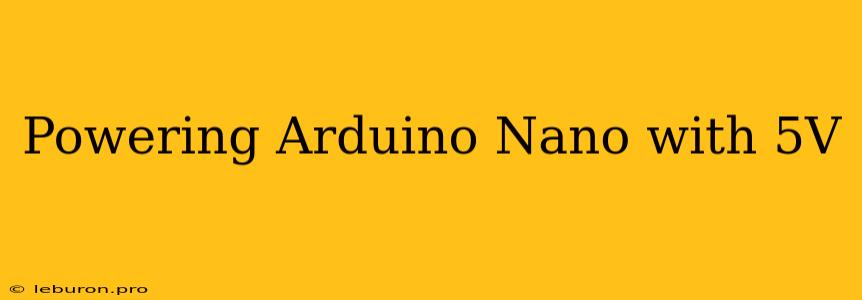The Arduino Nano, a versatile and popular microcontroller board, is often powered using a USB connection. However, for projects that require standalone operation, powering the Arduino Nano with a separate 5V source is essential. This article will explore the various methods and considerations for powering Arduino Nano with 5V, ensuring reliable and efficient operation for your projects.
Understanding Arduino Nano Power Requirements
The Arduino Nano operates on a 5V supply, and its power consumption varies depending on the components connected and the code running. Typically, it draws around 50mA in idle mode and can consume up to 200mA during heavy processing or when driving external devices. To power the Arduino Nano from a 5V source, you need to supply a current that meets or exceeds these requirements.
Methods to Power Arduino Nano with 5V
1. External Power Supply
Using an external power supply is the most straightforward way to power Arduino Nano with 5V. Here's how:
- Power Supply Selection: Choose a regulated 5V power supply with an output current rating higher than the Arduino Nano's maximum consumption. A typical power supply with a 1A rating would suffice for most applications.
- Connecting the Power Supply: Connect the positive (red) wire from the power supply to the Arduino Nano's "VIN" pin. Connect the negative (black) wire to the Arduino Nano's "GND" pin.
- Powering the Arduino Nano: Once connected, the Arduino Nano will draw power from the external power supply. You can verify this by checking the "Power" LED on the board, which should be illuminated.
2. Batteries
For portable projects, powering Arduino Nano with 5V using batteries is a viable option. However, you need to consider the following:
- Battery Type: Use a 5V battery, such as a Lithium-ion battery pack or a 5V USB power bank.
- Battery Capacity: Choose a battery with enough capacity to meet the project's runtime requirements. Consider the Arduino Nano's power consumption and the duration of your project.
- Battery Management: Use a battery management system (BMS) to ensure safe charging and discharge of the battery.
3. AC Adapter
An AC adapter is another option for powering Arduino Nano with 5V. It provides a stable and reliable source of power for long-term projects.
- Adapter Selection: Choose an AC adapter with a regulated 5V output and a current rating that meets the Arduino Nano's requirements.
- Adapter Connection: Connect the adapter's positive (center pin) to the Arduino Nano's "VIN" pin and the negative (outer ring) to the Arduino Nano's "GND" pin.
4. LiPo Battery
LiPo batteries are a popular choice for portable projects due to their high energy density and light weight.
- LiPo Battery Selection: Choose a 5V LiPo battery with appropriate capacity and discharge rate.
- LiPo Charger: Use a dedicated LiPo charger to safely charge the battery.
- Battery Management: Consider using a battery management circuit (BMS) to ensure safe charging and discharge.
Considerations for Powering Arduino Nano with 5V
1. Power Consumption
Before powering the Arduino Nano, it's crucial to estimate your project's power consumption. Factor in the current drawn by the Arduino Nano itself, as well as any connected peripherals. Exceeding the Arduino Nano's maximum current rating can lead to overheating and damage.
2. Voltage Regulation
Ensure that the power source provides a stable 5V output. Fluctuations in voltage can disrupt the Arduino Nano's operation and potentially damage the device. If using a battery or a source with a higher voltage, consider using a voltage regulator to ensure a steady 5V supply.
3. Reverse Polarity Protection
Protecting the Arduino Nano from accidental reverse polarity is essential. Use a reverse polarity protection diode or circuit to prevent damage if the power source is connected incorrectly.
4. Power Input Pin
When powering Arduino Nano with 5V, always connect the power source to the "VIN" pin. This pin is specifically designed for external power supply, while the USB connector should be used only for uploading code or debugging.
Conclusion
Powering Arduino Nano with 5V is a crucial step for creating standalone projects. Choosing the right method, ensuring the power supply meets the board's requirements, and implementing appropriate safety precautions are essential for reliable and long-lasting operation. With proper planning and implementation, you can successfully power your Arduino Nano projects and unlock a world of creative possibilities.
